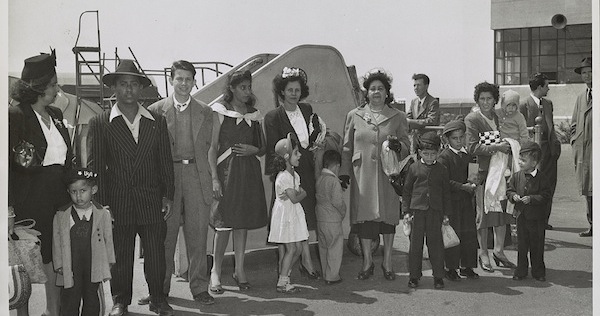
Photo by: Dick DeMarsica, Harlem/World Telegram & Sun, April 29, 1947, Courtesy of Library of Congress
From the collections of the Library of Congress, the photograph shows a group of Puerto Ricans in 1947 at Newark Airport in Newark, New Jersey. Granted United States citizenship with the passage of the Jones-Shafroth Act in 1917, Puerto Ricans began migrating to the U.S. in increasing numbers after World War I. By the post-World War II decades, they composed a significant percentage of the population of New York and, thereby, of the student population of the city’s public schools. Despite their status as American citizens, Puerto Ricans faced significant obstacles in realizing the full benefits of U.S. citizenship. Their native Spanish was a barrier to full incorporation and, because they were considered non-white, they experienced racial hostility and discrimination.1
While Puerto Ricans arrived in New York City in the early part of the twentieth century in small numbers, economic hardships and political tensions rooted in labor conflicts on the island led more and more to leave for the U.S. mainland.2 Representing a cross-section of economic and social classes, those who came made their homes in Central Harlem and in waterfront communities in Brooklyn, where they established networks of educational, cultural, economic, and political support.3 Amid the development of U.S. corporate interests, a significant uptick in population growth, and increasing unemployment on the island, the number of Puerto Ricans migrating to New York soared after World War II.4 In 1940, there were 61,000 Puerto Ricans living in New York City. By 1970, that number had jumped to 817,712 with Puerto Ricans accounting for over 10% of the total population of the city.5 While they settled in all boroughs of the city, by 1966, Puerto Ricans represented a majority of the population of the South Bronx, the Lower East Side, Williamsburg, and East Harlem.6
Not since the massive European immigration of the late nineteenth and early twentieth centuries had the New York City Board of Education been faced with educating a sizeable foreign-born student population. In the face of that challenge, the Board of Education commissioned a comprehensive multiyear study and published, in 1957, the voluminous, The Puerto Rican Study: 1953-1957.7 Part of a broad trend in the 1950s in New York and in the nation, whereby Puerto Ricans became the subject of research by social scientists and social welfare groups, The Puerto Rican Study addressed, most notably, language issues and the broad social and cultural needs of Puerto Rican students.8 Despite the research and the recommendations that followed, it was clear, nearly a decade later that sound, practical remedies had not been successfully implemented in the classroom to substantially improve the educational attainment of Puerto Rican children and youth. By 1969, students of Puerto Rican extraction composed 22% of the public school population in New York City and their dropout rate, across the 1960s, was as high as 85%.9 Compromised school achievement, which would become a chronic problem for generations of this student group, developed alongside the upheavals of urban renewal, entrenched racial and ethnic discrimination, and limited economic opportunities for broad segments of the Puerto Rican population in neighborhoods across the city.10
In the face of growing inequities, Puerto Ricans shaped multiple local institutional structures, campaigns, and protests to affirm their U.S. citizenship and to achieve justice across economic, social, and educational arenas.11 The full swing of the civil rights movement added momentum to their activism, which addressed multiple concerns from poor housing conditions to inadequate health care facilities to barriers to admission to the City University of New York, and finally, to the absence of effective bilingual and bicultural programs for Puerto Rican students at all grade levels in the public schools.12
1 Lorrin Thomas, Puerto Rican Citizen: History and Political Identity in Twentieth-Century New York City (Chicago: University of Chicago Press, 2010), 56-59.
2 Ibid.
3 Virginia Sánchez Korrol, “Puerto Ricans,” in The Encyclopedia of New York City, ed. Kenneth T. Jackson (New Haven: Yale University Press, 2010).
4 Thomas, Puerto Rican Citizen, 148-149.
5 Korrol, “Puerto Ricans.”
6 Joseph P. Fitzpatrick, Puerto Rican Americans: The Meaning of Migration to the Mainland (Englewood, NJ: Prentice-Hall, 1971), 55-57.
7 New York City Board of Education, The Puerto Rican Study: 1953-1957.
8 Thomas, Puerto Rican Citizen, 171-182.
9 William Vélez, “Educational Experiences of Hispanics in the United States: Historical Notes,” in Handbook of Hispanic Cultures in the United States: Sociology, ed. Félix Padilla (Houston: Arte Publico Press, 1994), 157.
10 Luis O. Reyes, “Minding/Mending the Puerto Rican Education Pipeline in New York City,” Centro Journal 25 (Fall 2012): 2-21.
11 See Virginia E. Sánchez Korrol, From Colonia to Community: The History of Puerto Ricans in New York City (Berkeley: University of California Press, 1983), chps. 5-6; Thomas, Puerto Rican Citizen, chp. 6.
12 Thomas, Puerto Rican Citizen, 214-244; Luis Reyes, “The Aspira Consent Decree: A Thirtieth-Anniversary Retrospective of Bilingual Education in New York City,” Harvard Educational Review 76 (September 2006): 369-400.